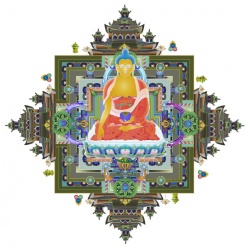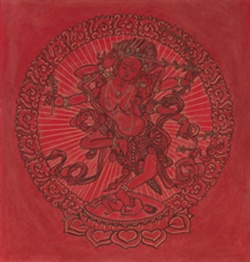King Bimbisara
King Bimbisara was the Buddha’s first Royal Patron. He ruled the kingdom of Magadha, the capital of which was Rajagaha, from the age of 15 when he ascended the throne until his death at the age of fifty-two.
King Bimbisara saw the Buddha for the first time prior to His enlightenment. The Ascetic Gotama was seeking alms in Rajagaha when the king saw the Great Ascetic of royal carriage and great bearing. Wishing to find out who this Great Ascetic was, the King with his royal entourage followed the Ascetic Gotama to Pandavapabbata, where He was resting after His meal. He then questioned the Ascetic Gotama on His birthplace and ancestry. Ascetic Gotama replied :
"Just straight, O King, upon the Himalayas, there is, in the district of Kosala of ancient families, a country endowed with wealth and energy. I am sprung from that family, which by clan belongs to the Solar Dynasty, by birth to the Sakyans. I crave not for pleasures of the senses. Realizing the unwholesomeness of sensual pleasures and seeing renunciation as safe, I proceeded to seek the Highest, for in that my mind rejoices.?
The King then invited the Ascetic Gotama to visit his City once He had attained enlightenment. In keeping with the promise that He had made, the Buddha visited Rajagaha after His enlightenment. Travelling from Gaya to Rajagaha, He stayed at the Suppatittha Shrine in a palm grove.
The news of the Buddha’s arrival soon spread across the city. His reputation as a great teacher and the reverence with which His Teaching was heralded, had spread to Rajagaha. The King welcomed the Buddha with a large retinue of attendants He then paid reverence to Him and sat respectfully to the side. As both the Buddha and Maha Kassapa were in attendance some of the people were not sure who was the teacher and who the pupil. Reading their minds, the Buddha questioned Kassapa as to why he had given up fire-sacrifice, a Brahmanic ritual. Recognizing the doubts in the minds of the people, Kassapa said that he had given up fire sacrifice because he preferred the passionless, peaceful state of Nibbana. Then, falling at the feet of the Buddha, he paid reverence and said, ?My Teacher, Lord, is the Exalted One – I am the disciple."
The people were inspired by Kassapa’s devotion. The Buddha then dispensed the Maha Narada Kassapa Jataka, where in a previous birth the Bodhisatta had helped Kassapa in a similar way. On hearing the Dhamma, King Bimbisara attained the first stage of sainthood, Sotapanna. After taking refuge in the Buddha, Dhamma and Sangha, the king invited the Buddha and His retinue to the palace for their meal on the following day.
After the meal, King Bimbisara asked the Buddha what type of place would be suitable for His residence. The Buddha said that a place which was secluded and quiet, not too far but not too close to the city, would be pleasing to Him. Reflecting that his bamboo grove would be a perfect residence, the king donated the park to the Buddha and the Sangha. Even though the Buddha’s new residence was known as Veluvanarama and arama is used to denote a monastery, there were no buildings or monastery at the bamboo grove. The Buddha and His monks resided under the shelter of the trees. The Buddha spent six years of the rainy season at Veluvanarama.
After His conversion the King led the life of an exemplary monarch. He had two consorts, Kosala Devi, who was the sister of King Pasenadi Kosala, and Khema, who later became the chief female disciple of the Buddha. His Queen, Kosala Devi, gave birth to a son whom they named Ajatasattu.
Even though King Bimbisara led a righteous life he had a sad, pathetic death. Ajatasattu, led by Devadatta, attempted to kill his father to gain the throne. When King Bimbisara became aware of his son’s plan, the compassionate king handed over the throne to his son and stepped down from the monarchy. The ungrateful son, who was under Devadatta’s wicked influence, threw his father in prison with the instructions that he should be left without food, to starve to death. His mother alone had free access to the prison.
The loyal queen carried food in her waist pouch, but before long Ajatasattu became aware of his mother’s efforts. When he forbade her to carry food in her waist pouch she carried food concealed in her hair knot. When this too was discovered and forbidden she applied a mixture of honey, butter, ghee, and molasses all over her body and let the king lick her skin to sustain himself.
The cruel Ajatasattu then denied his mother access to visit the King. King Bimbisara was without any means of sustenance. But being a Sotapanna, he lived in meditative bliss and spiritual happiness. Ruthlessly, Ajatasattu ordered his barber to slash the old king’s feet and place a mixture of salt and oil on the wounds. He then commanded him to walk on hot coals. Upon seeing the barber, King Bimbisara thought that his son had realized the folly of his behaviour and was sending the court barber to help cut his hair and beard so that he could be cleaned up for release. But it was not to be. The barber started the inhumane torture as instructed by the new king. The aged King Bimbisara died in extreme agony as the result of an unwholesome action performed in a past life.
On the same day that the old king died the news was brought to Ajatasattu that his wife had given birth to a baby son. Overcome by parental joy and happiness the king asked his mother if his father too had loved him as he did this new-born babe. His mother, Kosala Devi, then informed the cruel Ajatasattu of the great love that Bimbisara had had for him.
Ajatasattu’s mother revealed that when she was carrying him there had arisen in her an inhuman desire to drink the blood from the hand of the king. She had concealed this desire but had withered away as it was a craving that she could not control. On hearing of her problem the king gladly cut open his palm to let her drink his blood.
The sages who could foretell the future had declared that this son would be an enemy of the king. The queen had then wanted to abort the baby but King Bimbisara, full of love and pride for the unborn child, had refused. Later, when the baby was born, the sages had again foretold that he would be an enemy of the king. For the second time the queen had wanted to kill the baby. For the second time the king had prevented her from killing her son. The queen had named the baby Ajatasattu, or unborn enemy.
The queen then added that on one occasion when an infected boil on the baby’s foot had made him fretful and angry she had taken him to the court to ask the king’s advice. On hearing of the problem the king had placed the baby’s foot in his mouth and sucked at the boil. The boil had then burst, spitting pus and blood into his mouth. The king, full of love and compassion, had swallowed the pus and continued to soothe the baby.
Ajatasattu was filled with shame and regret upon hearing his mother’s words. He sent a message to release his father but it was too late. King Bimbisara had closed his eyes forever, and was immediately reborn in the Catumaharajika Heaven as a god named Janavasabha. Influenced by the Dhamma, King Ajatasattu changed, and became one of the lay followers of the Buddha and the patron of the First Sangha Council.



